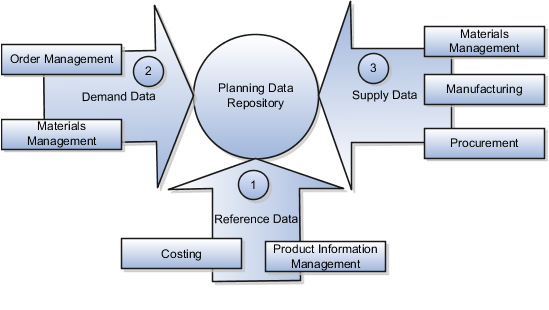How You Collect Different Data Types for Supply Chain Planning
When you collect data, you collect data from three categories: reference data, demand data, and supply data. On the Collect Planning Data page there is a tab for each of these categories.
The collected data are stored in the planning data repository.
The following figure illustrates the three categories of data that you collect from the Oracle Fusion source system to the planning data repository.

Explanation of Callouts
-
Reference data is primarily sourced from Oracle Fusion Cloud SCM
-
Demand data comes from Oracle Fusion Cloud Order Management and Oracle Fusion Cloud Inventory Management
-
Supply data is sourced from Oracle Inventory Management, Oracle Fusion Cloud Manufacturing, and Oracle Fusion Cloud Purchasing
Reference Data
The collection process begins with reference data, which is primarily sourced from Oracle Fusion Cloud SCM. You collect the data collection entities, such as basic item, resource, organization, customers and suppliers, and calendar data.
You also use Oracle Fusion Cloud Supply Chain Planning to collect the following items:
-
Item structures: To explode item-level demand into component demands and supplies.
-
Work Definitions: To assign the component and resource requirements for make items.
-
Units of measure: To align plan data and to convert plans from one set of units to another.
-
Costs: To review plans in financial terms and evaluate the financial impact of planning decisions.
Demand Data
You collect demand data from two potential sources:
-
Sales orders that flow from Oracle Fusion Cloud Order Management: You can use this as the basis of the demand forecast, while current orders can consume the demand in near-term forecast time buckets.
-
Shipment history from Oracle Fusion Cloud Inventory Management: You can use this to generate a shipments forecast.
Supply Data
You collect supply data from three sources:
-
Oracle Inventory Management: This provides data related to on hand inventory, reservations, material transfers, in-transit supplies, and receipts.
-
Oracle Manufacturing: This provides work in process status and any manufacturing work orders.
-
Oracle Purchasing: This provides purchase requisitions and purchase orders.